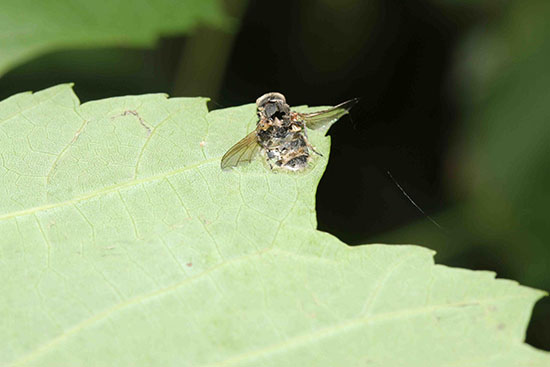Issue 12, July 20, 2015
Fungus-killed Flies
Fungus-attacked anthomyiid flies are being found on the ends of tree and shrub branches. Anthomyiid flies are gray and look like house flies but are slightly smaller. Many of them are leafminers or root feeders in the larval stage, and they are not generally considered to be pests of ornamental plants.

Anthomyiid fly killed by fungus on silver maple leaf.
They and other flies are attacked by the fungus, Entomophthora muscae, that apparently causes the fly to crawl to the end of the branch, leaf, or other upright object before it dies. It hangs onto the branch as it dies. The abdomen swells, and the legs and wings stick out. White fungal hyphae grow out of the insect and further attach it to the branch or leaf. Spores are then produced that spread on the wind more effectively from the elevated location.
Spores landing on adult flies germinate, and the hyphae penetrate the body to feed on the hemolymph, the blood, of the fly. Within a week, the fly is dying and climbing upwards. This fungus tends to be most common after rains in moderate temperatures. The lower temperatures during the last couple of weeks combined with the continuing rains this summer have been conducive to this fungus.
This year, the dead flies on the ends of branches and leaves are so numerous that the plants appear to be attacked by them. Obviously, there is no damage caused by or control needed for dead flies. If you have a client that requires their removal, they are usually attached too tightly to be knocked off with a water spray. They usually require hand-removal.
Much of the above information was taken from a fact sheet written by Whitney Cranshaw, Colorado State University available at https://bspm.agsci.colostate.edu/files/2013/03/Fly-Fungus.pdf. (Phil Nixon)
Author:
Phil Nixon